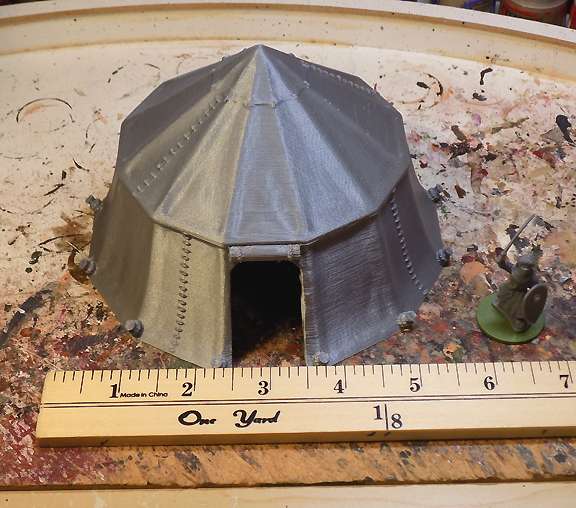The introduction to the
Lords of the Wild faction in
SAGA: Ago of Magic reads:
"In the most inaccessible parts of the world, there live peoples who have prospered while cut off from the more developed civilizations which surround them. For cultural, spiritual or traditional reasons, these societies have never sought to exploit their environment, instead seeking harmony with the surroundings which provide them with what they need to develop.These peoples, who we call the Lords of the Wild, can be human, but often have traits which differentiate them from their peers. They might be animal hybrids, ancient elves, gnomes or hobgoblins. Their existence gives life to the legends we tell to children, and embodies a mass of superstitions. They are often feared and misunderstood. Entering into their homeland unleashes their fury and has been he cause of numerous wars they have wreaked upon their neighbors.These societies generally organize themselves on tribal or clan lines, beneath the authority of a king or chief. They are rarely geographically spread out, since the difficulty of establishing lines of communications in these hostile environs constitutes a real brake on their development."When I first read this introduction, my mind immediately jumped to the most common Fantasy forest dweller tropes (e.g. wood elves, treefolk, beastmen, etc), but then a couple of weeks ago, while I was working on my SAGA Moors and thinking about ways to fit them into Age of Magic, I got a great idea. The
Lords of the Wild description could apply to tribes of desert nomads, like the ancient, pre-Islamic Bedouin tribes of Arabian peninsula. These tribes lived in a desolate wilderness that they could not shape, so instead they adapted. To the people of neighboring civilizations who dwelt in cities or in small agricultural communities, the desert nomads were likely thought of as strange, insular, people whose ability to survive in the desert made them both mysterious and more than a little threatening.
Below is a WIP shot of my initial warband. As I play-test the warband, I expect that its composition will change over time.
Warlord -flying beast
Sorcerer
Ranger
4 Shapeshifters
8 Warriors -mounted
10 Warriors -bows
9 Warriors
9 Warriors
12 Levy -javelins
The camel cavalry and plastic spearmen are all Gripping Beast minis. The levy are from Perry Miniatures' Sudanese Tribesmen plastic kit. The metal archers are Artizan Design's Berber Bowmen.
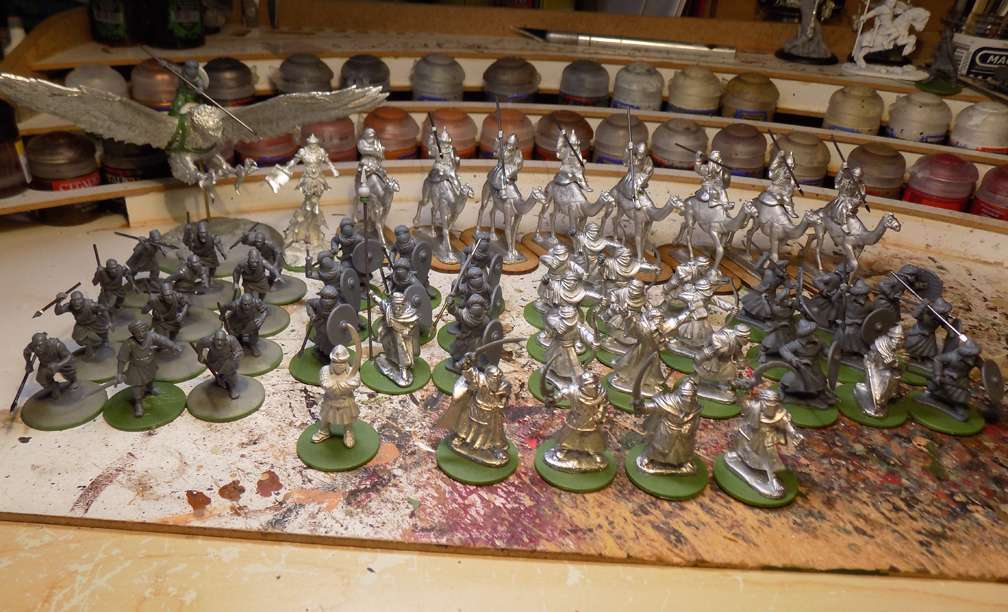
My Warlord is a converted Wind Rider from Game Zone Miniatures' Sylvan Elf line. The original model's rider is assembled from two pieces. I kept the lower piece, the legs and saddle, and replaced the upper piece with some bits from Gripping Beast's plastic Arab Spearmen kit. The legs were armored, so I covered them up with GS Arab leggings and belt sash. I used GS to add a saddle horn and a harness to hold the saddle in place.
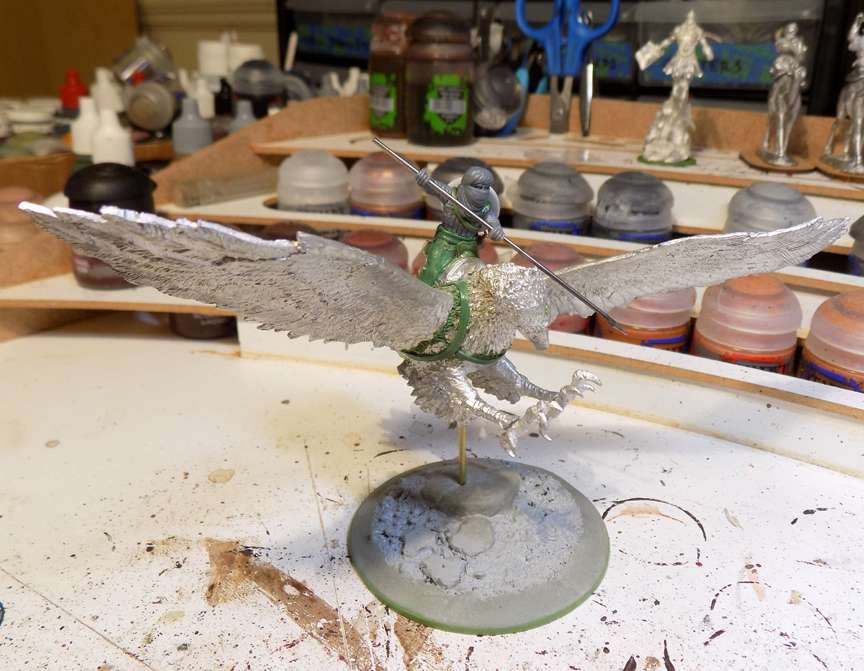
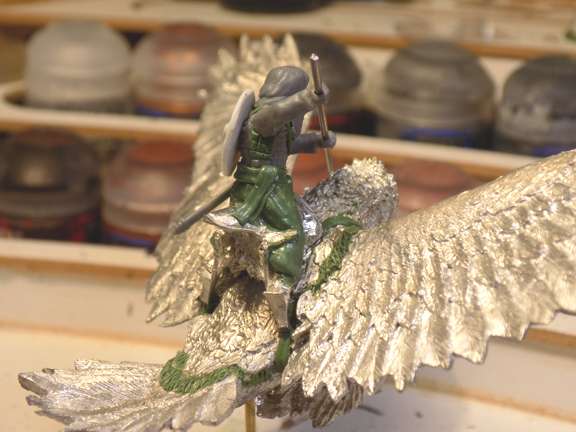
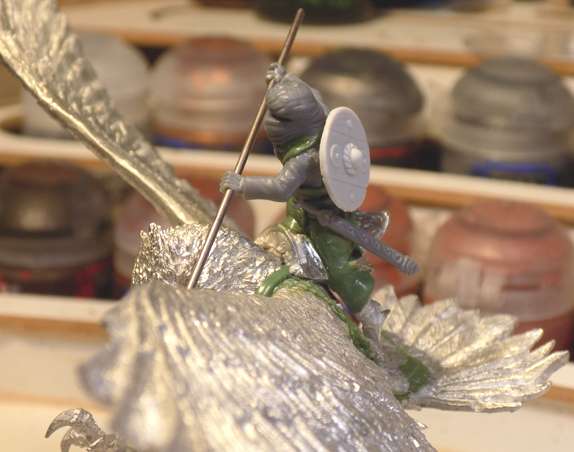
For my Sorcerer, I am using the Salah ad-Din model from Cipher Studios (now OOP) Hell Dorado Saracen model line. I've cut down the size of the wave of sand he's perched on to fit the 25mm base.
For my Ranger, I am using the Mutatawwi’a Warlord from Stronghold Terrain's SAGA Collectibles model line.
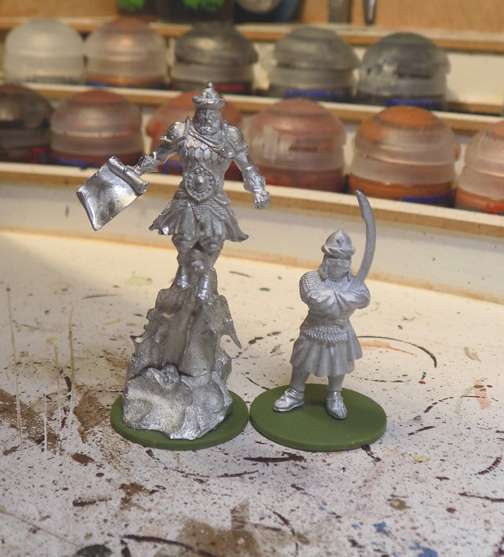
The concept that I am most pleased with is how I am going to represent the warband's Shapeshifters.
In a Lords of the Wild warband, 1 point will buy you 4 Shapeshifters (each has an aggression of 5). These models are "hidden" in units of Warrior foot units (up to 2 models per unit). When that unit fights in its first melee, the Shapeshifters are revealed by replacing normal models in the unit with Shapeshifter models. The basic idea behind this rule mechanic goes WAY back to 3rd Edition's Warhammer Armies Book, which was published in 1988.
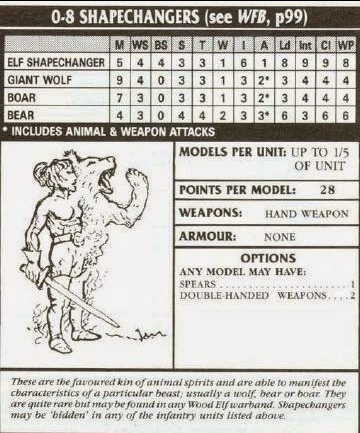
I'm not familiar enough with pre-Islamic Arab myths to know if it included lycanthropy or human shapeshifters, but I do know that the word 'assassin' comes to the English language from an 11th century Muslim sect who trained and directed operatives to infiltrate enemy strongholds and courts to kill clerics, rulers, and officials. The most commonly-repeated theory holds that the word" Hashshashin" or "Assassin" comes from the Arabic hashishi, meaning "hashish users." Chroniclers including Marco Polo claimed that the followers of this sect committed their political murders while under the influence of drugs, hence the derogatory nickname. The Koran includes a strict injunction against intoxicants, so claims of hashish use by this sect may have been propaganda created by the European Crusaders or the Seljuk Turks -the latter group were the sect's most frequent target.
Regardless of how the sect's killers got their nickname, the connection to the Arab history is enough for me to incorporate it into my theme. So, instead of men turning into beasts, my warband's "Shapeshifters" will be represented by deadly assassins, who when battle is joined, toss aside their disguises to reveal infamous killers of legend. And by "legend" I mean my own fantasy version of the sect, not the historical version.
These models are Artizan Designs' Black Guard from their Moors model line. I want my assassins to be more fantastic and flamboyant than their namesakes, so I replaced their right hands and original weapons with fancy curved swords from Frostgrave's Cultist plastic kit. To make them clearly stand out from my rank-and-file models, I'll paint them all in black..
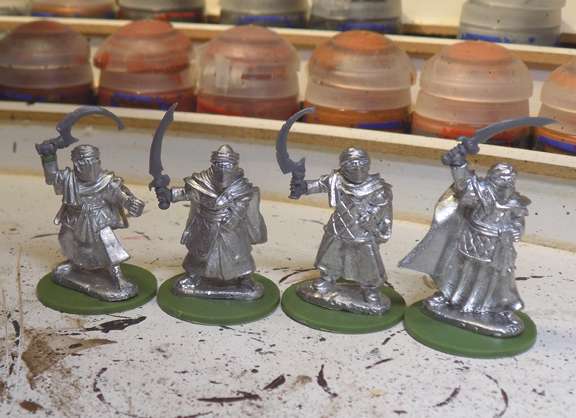
Lastly, since my Lords of the Wild warband are nomads, using a static object for my Sacred Ground terrain simply won't due. Instead, I am going to use this tent that I bought from a 3D printer on Etsy, to serve as my warband's Sacred Ground. Presumably, the tent will contain the nomad's most sacred relics.
The plan is to mount it on a styrene base, and fancy it up some by adding a couple of resting camels and other interesting thematic bits.
